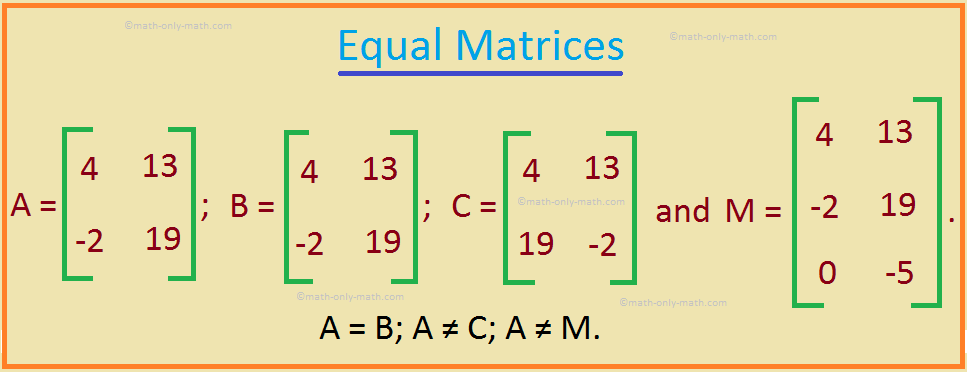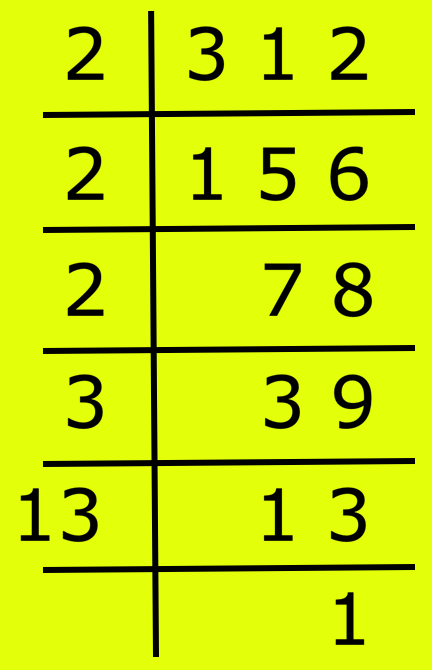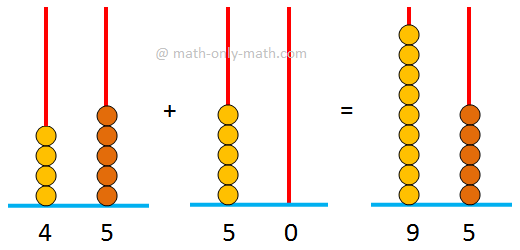Equal Matrices
Equality of two matrix: Two matrices [aij] and [bij] are said to be equal when they have the same number of rows and columns and aij = bij for all admissible values of i and j.
Definition of Equal Matrices:
Two matrices A and B are said to be equal if A and B have the same order and their corresponding elements be equal. Thus if A = (aij)m,n and B = (bij)m,n then A = B if and only if aij = bij for i = 1, 2, 3, ....., m; j = 1, 2, 3, ......., n.
The number of rows in matrix A = The number of rows in matrix B and The number of columns in matrix A = The number of columns in matrix B
Corresponding elements of the matrix A and the matrix B are equal that is the entries of the matrix A and the matrix B in the same position are equal.
Otherwise, the matrix A and the matrix B are said to be unequal matrix and we represent A ≠ B.
Two matrices are called equal if and only if
(i) they are of the same order, i.e., the number of rows and the number of columns of one are same as those of the other, and
(ii) corresponding elements are equal, i.e., elements in the same position in both are equal.
For example:
Let
(i) A = B because A and B are of the same order, 2 × 2, and corresponding elements are equal. [Here, (1, 1)th element = 4 in both, (1, 2)th element = 13 in both; (2, 1)th element = -2 in both and (2, 2)th element = 19 in both.]
(ii) A ≠ C because corresponding elements are not equal. [Here, (2, 1)th element of A = -2 but (2, 1)th element in C = 19.]
(iiI) A ≠ M because they are not of the same order. [Here, A is a 2 × 2 matrix while M is a 3 × 2 matrix.]
Examples of Equal Matrices:
1. The matrices A = [5] and B = [5] are equal, because both matrices are of the same order 1 × 1 and their corresponding entries are equal.
2. The matrices A = [2731] and B = [2731] are equal, because both matrices are of the same order 2 × 2 and their corresponding entries are equal.
3. The matrices A = [46125970−3] and B = [46125970−3] are equal, because both matrices are of the same order 3 × 3 and their corresponding entries are equal.
4. The matrices A = [2−165543−37−7952384] and B = [2−165543−37−7952384] are equal, because both matrices are of the same order 4 × 4 and their corresponding entries are equal.
From Equal Matrix to HOME PAGE
Didn't find what you were looking for? Or want to know more information about Math Only Math. Use this Google Search to find what you need.
Recent Articles
-
5th Grade Factors and Multiples | Definitions | Solved Examples | Math
Mar 23, 25 02:39 PM
Here we will discuss how factors and multiples are related to each other in math. A factor of a number is a divisor which divides the dividend exactly. A factor of a number which is a prime number is… -
Adding 2-Digit Numbers | Add Two Two-Digit Numbers without Carrying
Mar 23, 25 12:43 PM
Here we will learn adding 2-digit numbers without regrouping and start working with easy numbers to get acquainted with the addition of two numbers. -
Worksheet on 12 Times Table | Printable Multiplication Table | Video
Mar 23, 25 10:28 AM
Worksheet on 12 times table can be printed out. Homeschoolers can also use these multiplication table sheets to practice at home. -
Vertical Subtraction | Examples | Word Problems| Video |Column Method
Mar 22, 25 05:20 PM
Vertical subtraction of 1-digit number are done by arranging the numbers column wise i.e., one number under the other number. How to subtract 1-digit number vertically? -
Worksheet on 11 Times Table | Printable Multiplication Table | Video
Mar 22, 25 05:08 PM
Worksheet on 11 times table can be printed out. Homeschoolers can also use these multiplication table sheets to practice at home.







New! Comments
Have your say about what you just read! Leave me a comment in the box below. Ask a Question or Answer a Question.